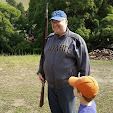Now that the primer has cured, actual skilled painting can begin!
I pride myself on historical accuracy. I have been compiling my reference library for 25 years now. If we can collectively know anything about uniforms and equipment, you can be sure I have the source in my library.
Whenever the French publisher "Histoire & Collections" releases a book, I snap it up. They do not usually last long, and they fetch huge prices on the secondary market. This one sells for only $20 on Amazon right now, but other volumes can fetch over $400 each.
I scan the uniform plates I want and copy them into a Word document. All the images I use stay in that document until I know my customer is pleased with the figures. This way if any concerns about accuracy arise, I have my sources right at hand.
My brushes serve different purposes in different stages of life. The leftmost container has the old, tired brushes that are only good for slopping heavy paint and drybrushing. The middle brushes are for enamels and more detailed blunt work. The right container has my first run brushes, suitable for detail painting.
This rotating paint rack holds 160 two ounce craft paint bottles. Most of my painting uses these inexpensive paints.
An old jam jar contains my cleaning water. I will use a Windsor and Newton Series 7 miniature brush, size 3, for this first step. Backpacks and red plumes get a basecoat of Delta Ceramcoat "Brown Iron Oxide," one of the more useful colors in my stable. Scratch paper from my office serves as my palette.
The last and most important tool is a good light source. I use this Ottlite, which I bought for about $20. I never wear magnifying glasses for painting. I my eyes cannot see the detail unaided, it is not going to be visible to anyone else either.
I paint brown backpacks with the brown iron oxide. It dries fairly dark, providing a good base for the drybrush to follow.
Any red plumes also get this deep brown as a base. For green plumes I use DecoArt's "Evergreen," and white plumes get Delta Ceramcoat "Mudstone."
All 468 figures now have basecoats on backpacks, plumes, drum bodies, and eagles. After a night's curing, I will be able to start drybrushing.





















That is a lot of brushes!
ReplyDeleteI rarely throw any away. I can always find a use for an old, worn-out brush.
Delete